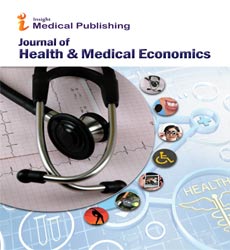Health Economics of Telemedicine: Opportunities and Challenges Post-Pandemic
Victor Toscano
Department of economics, International Hellenic University, 65404 Kavala, Greece
Published Date: 2025-01-28Victor Toscano*
Department of economics, International Hellenic University, 65404 Kavala, Greece
*Corresponding author: Victor Toscano, Department of economics, International Hellenic University, Kavala, Greece, E-mail: victor@toscano.gr
Received date: January 01, 2025, Manuscript No. Ipjhme-25-20583; Editor assigned date: January 03, 2025, PreQC No. ipabs-25-20583 (PQ); Reviewed date: January 15, 2025, QC No. ipabs-25-20583; Revised date: January 22, 2025, Manuscript No. ipabs-25-20583 (R); Published date: January 28, 2025, DOI: 10.36648/ 2471-7975.12.1.154
Citation: Toscano V (2025) Health Economics of Telemedicine: Opportunities and Challenges Post-Pandemic. J Health Med Econ Vol.11 No.1:154
Abstract
Introduction
The rapid expansion of telemedicine during and after the COVID-19 pandemic has reshaped healthcare delivery and placed health economics at the forefront of evaluating its sustainability. By reducing travel costs, increasing accessibility, and supporting continuity of care, telemedicine promises significant economic and clinical benefits. However, it also presents challenges in reimbursement models, infrastructure investment, and equity of access, raising important questions about how health systems can optimize its role in post-pandemic healthcare [1].Description
From an economic perspective, telemedicine creates opportunities for cost savings at both individual and system levels. Patients benefit from reduced transportation expenses, less time off work, and faster access to consultations, while healthcare systems can reduce unnecessary hospital visits, streamline chronic disease management, and optimize specialist availability. These factors collectively improve efficiency and may reduce long-term healthcare expenditures by shifting the focus toward preventive and outpatient care. Yet, the financial advantages depend on careful integration into existing workflows to avoid duplication of services or overutilization [2]. The pandemic accelerated the adoption of telemedicine by breaking down regulatory and technological barriers, but sustaining it requires stable economic models. Reimbursement parity between virtual and in-person visits, investment in secure digital platforms, and training of healthcare professionals are critical to ensure quality and efficiency. Health economists must also consider the potential for cost redistribution, where savings from reduced facility use may be offset by higher demand due to the convenience of telemedicine. In addition, while telemedicine can expand access to underserved populations, it risks widening disparities for those without digital literacy, reliable internet, or necessary devices. On a broader scale, telemedicine offers value beyond direct financial metrics by enhancing patient satisfaction, reducing infection risks, and enabling remote monitoring technologies for chronic diseases. These benefits translate into indirect economic gains such as improved workforce productivity and better long-term health outcomes. However, challenges remain in aligning incentives for providers, ensuring equitable access, and maintaining data privacy and security standards. Policymakers and healthcare administrators must therefore balance short-term investment with long-term cost savings, while also implementing frameworks that measure outcomes effectively [3]. Health insurance remains a pivotal instrument in reducing medical inequalities, but its impact depends on the depth of coverage, equity in access, and the effectiveness of financial protection it provides. While insurance schemes can mitigate catastrophic expenditures and improve access to essential health services, disparities often persist due to gaps in benefit design, variations in provider availability, and socioeconomic barriers beyond insurance itself. Therefore, a comprehensive approach is requiredâ??one that combines universal and equitable insurance coverage with systemic reforms in healthcare delivery, targeted subsidies for vulnerable groups, and policies addressing social determinants of health [4,5].Conclusion
In summary, the health economics of telemedicine post-pandemic reveals a dual picture of significant opportunities for cost savings, accessibility, and improved health outcomes alongside challenges related to reimbursement, infrastructure, and equity. To fully harness its potential, healthcare systems must adopt innovative financing models, invest in digital infrastructure, and address disparities in access. When strategically implemented, telemedicine can serve as a cost-effective and sustainable complement to traditional healthcare delivery, driving efficiency and resilience in future healthcare systems.Acknowledgement
None.Conflict of Interest
None.References
- Philip P, Sagaspe P, Lagarde E, Léger D, Ohayon MM, et al. (2010) Sleep disorders and accidental risk in a large group of regular registered highway drivers. Sleep Med 11: 973-979
Google Scholar Cross Ref Indexed at
- Mulgrew AT, Ryan CF, Fleetham JA, Cheema R, Fox N, et al. (2007) The impact of obstructive sleep apnea and daytime sleepiness on work limitation. Sleep Med 9: 42-53
Google Scholar Cross Ref Indexed at
- Hoffman B, Wingenbach DD, Kagey AN, Schaneman JL, Kasper D (2010) The long-term health plan and disability cost benefit of obstructive sleep apnea treatment in a commercial motor vehicle driver population. J Occup Environ Med 52: 473-477
Google Scholar Cross Ref Indexed at
- Patil SP, Ayappa IA, Caples SM, Kimoff RJ, Patel SR, et al. (2019) Treatment of adult obstructive sleep apnea with positive airway pressure: An American Academy of Sleep Medicine clinical practice guideline. J Clin Sleep Med 15: 335-343
Google Scholar Cross Ref Indexed at
- Sharples L, Glover M, Clutterbuck-James A, Bennett M, Jordan J, et al. (2014) Clinical effectiveness and cost-effectiveness results from the randomised controlled trial of oral mandibular advancement devices for obstructive sleep apnoea-hypopnoea (TOMADO) and long-term economic analysis of oral devices and continuous positive airway pressure. Health Technol Assess 18: 1-296
Google Scholar Cross Ref Indexed at
Open Access Journals
- Aquaculture & Veterinary Science
- Chemistry & Chemical Sciences
- Clinical Sciences
- Engineering
- General Science
- Genetics & Molecular Biology
- Health Care & Nursing
- Immunology & Microbiology
- Materials Science
- Mathematics & Physics
- Medical Sciences
- Neurology & Psychiatry
- Oncology & Cancer Science
- Pharmaceutical Sciences
